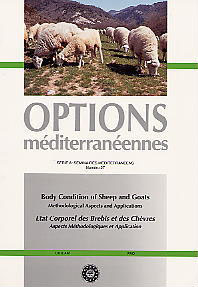| Article précédent | p. 53-58 | Article suivant |
Evolution of ewe body condition and the production of lamb and milk in different productive strategies
The autochthonous Merino ewe in extensive systems plays an important role in Southwest Spain. The seasonal variation in food availability in these areas produces changes in the body condition score of ewes. It needs different grazing strategies to cover the sheep requirements, according to the production levels. Some of these strategies are studied in a factorial design where the variation factors are reproductive rhythm and seasonal milking. The evolution of body reserves during the year shows different variance ranks depending on the reproductive rhythm, but no significant differences were caused by the milking effect. Feed requirements were increased when the lambing schedule was accelerated. In contrast, milking did not require more feeding in the ewe. The conclusions are: (i) the results obtained in the extensive management systems of the Merino sheep show that intensification increases the total production and the supplementation, but it decreases the body condition score; and (ii) it is possible to set up three global intensification levels.
- [ Afficher ]
- [ Télécharger ]
- [ Exporter la citation ]
Vous pouvez télécharger la citation au format :
- [ Imprimer ]
-
Mots-clés
ETAT CORPOREL, PRODUCTION LAITIERE, VIANDE OVINECiter cet article
López F., Espejo M., Villar A. Evolution of ewe body condition and the production of lamb and milk in different productive strategies. In : Purroy A. (ed.). Body condition of sheep and goats: Methodological aspects and applications . Zaragoza : CIHEAM, 1995. p. 53-58. (Options Méditerranéennes : Série A. Séminaires Méditerranéens; n. 27). Seminar of the Working Group on Body Condition of Sheep and Goats of the FAO/CIHEAM Network on Sheep and Goats, 24-31 Mar 1994, Zaragoza (Spain). http://om.ciheam.org/om/pdf/a27/96605593.pdf



